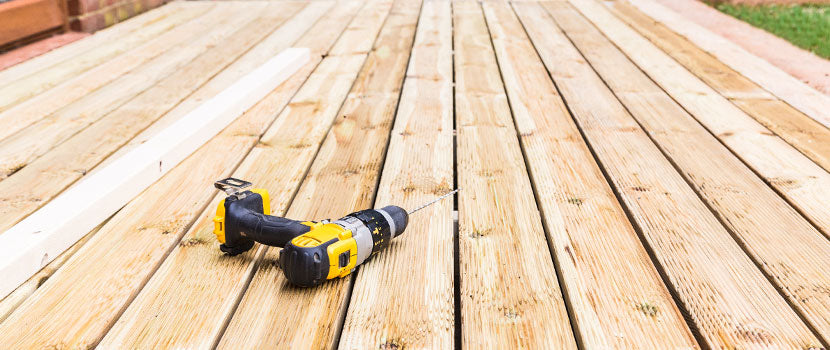
Tools Needed to Build a Deck

Do you have the desire to build a deck, but don’t know where to start? Fasteners Plus is here to help by giving you tips on what tools will help you get the job done like a pro! So, before you make a large purchase on deck materials, make sure you are prepared with the tools that will set you up for success.
Continue reading to learn what tools will help you complete multiple steps of the deck building process such as excavating footers, laying out/marking, cutting, fastening, and shaping/smoothing deck boards.
Tools for Post Footing Excavation
Digging Tools
- Pointed Digging Shovel
- Trench Shovel
- Digger Bar
- Post-Hole Shovel
- Wheelbarrow
- Bucket
One of the first steps in the deck building process is marking where your deck footings will be and digging the holes for them. There is no avoiding the digging that has to be done when installing a deck. Digging can be an unpleasant task so rallying a team of helpers and using a high-quality digging tool will make a huge difference in the time and effort it will take. When digging holes for post footings, a pointed digging shovel is a great tool for breaking up the ground and getting the hole started.
If the soil is difficult to dig, a digger bar is a very helpful tool. This tool has a chiseled end and efficiently breaks down rocky soil that can be scooped out with your shovel. A post-hole shovel comes in handy for reaching into a hole and pulling the soil out with its scoop.

Augers
If you want to eliminate the back pain and excessive sweating from digging holes, an auger is an ideal choice for you. An auger has a spiraling metal shaft with a blade at the end known as “flighting.” The flighting rotates to scrape, cut, and pull out drilled materials. The drilled material moves along the flighting and comes out of the hole during the blade’s rotation. There are many handheld or machine-auger options to choose from.
Deck Layout and Marking Tools
Tape Measure
A tape measure is a necessary tool when it comes to any construction project. If you are building a large-sized deck, your tape measure should span 25'. When you use a tape measure to install deck boards, the edges of your deck will have a clean, seamless look.
Chalk Lines
Additionally, chalk lines are super helpful when building a deck. To use a chalk line, pin down one end of the line and pull the other end to the distance where you want to mark. Once in the right position, snap the chalk line onto the level surface. The chalk line is great for showing an accurate line where screws should be installed. Blue or white chalk is recommended due to the color washing off of deck boards easily.
Carpenter’s Level
After taking the time to cut all your deck boards, you want to make sure your boards are being installed level. A carpenter’s level is the perfect tool for checking the accuracy of the foundation of your deck. Having a level structure is important for both appearance and safety.

Framing and Speed Squares
Framing and speed squares make checking accuracy easy. Framing squares, also known as carpenter’s squares, are used for checking the corners of the deck to make sure they are squared. Speed squares are used for marking measurements of the deck boards.
Power Tools
Power tools have changed the game by making construction jobs more efficient than ever. Saws are power tools that have evolved over time with many options available. Saws are used to cut materials to accurate dimensions. Each saw has different features that work better in certain applications than others. The saw blade is an important factor in having a successful cut as well.
Circular Saws
Circular Saws are commonly used saws due to their mobility and ease of use. They have a sharp blade that rotates and cuts precisely through the material. These saws have a protective frame around the top and sides of the blade. The circular saw is best for straight cuts.
Styles:
- Corded Circular Saw
- Cordless Circular Saw
- Portable Circular Saw
- Hand-Held Circular Saw

Miter Saws
Miter saws are heavier power tools than circular saws. They are designed to cut different angles. The blade on the miter saw is attached to the swing arm that you pull down to cut. There are several styles of miter saws available that have different titling abilities.
Styles:
- Compound Miter Saw
- Sliding Compound Miter Saw
- Dual Compound Miter Saw

Table Saws
A table saw is a type of saw that is recommended for a more experienced cutter. A table saw is attached to a table and has a blade that points out of a slot in the table. To cut your material, push it on the table and the blade will seamlessly cut through it. Table saws are adjustable and can accurately cut vertical and horizontal cuts. They are available in portable options as well.

Vacuum & Dust Extraction
Dust particles and sawdust are harmful and can be a pain to deal with on the job site. You will thank yourself later after purchasing a vacuum to clean up the mess that accumulates. Metabo's Dust Extraction Vacuum is an all-purpose vacuum that will take care of the mess with ease.
To avoid breathing in any harmful dust particles when cutting wood, don’t forget to wear eye protection and a face mask as well.
Power Drills and Fastening Tools
Cordless Electric Drills
A cordless electric drill is a commonly used power drill on a deck build. An electric drill that uses 18-volt batteries or higher would be the best option for power and longevity. These drills can be used for drilling small pilot holes in deck boards for the screws or drilling bigger holes for installing lag bolts. Cordless drills that have torque clutches and multiple gear ratios are recommended for optimal performance.
Impact Drills
Impact drills are continuously gaining traction in the construction and DIY industry. This cordless power drill uses a rotational hammering action to drive lag screws or deck screws into the deck boards. It does it in such a precise way that It prevents stripping screw heads altogether. The impact drill also has minimal torque to your hand and wrist compared to regular drill options.
Hammers
Hammers are convenient to own for a variety of different uses. For deck installation, hammers are the ideal tool for pounding wood stakes into the ground for the deck foundation. A sturdy, heavy hammer delivers the best results for this.
Fasteners
Fasteners are extremely important when installing a deck. If you use a low-quality fastener, it is likely that your structure won't stay secure. Fasteners Plus offers a wide variety of high-quality fasteners, joist hangers, and post bases that can bring your deck plan together. Before purchasing your deck fasteners, it is important to understand how the material of the fastener affects the deck. Click here to read more on how to avoid screw corrosion and the best deck screw options for building a long-lasting structure.

Sanding and Staining
Once a deck is initially installed, it looks stunning! However, if you don’t stain the surface, it is likely to weather and become discolored over time. If you wash off, then sand the deck boards before staining, your stain absorbs into the wood and gives the deck a beautiful look that lasts longer. Sanding also removes any splinters and rough patches providing a smooth, clean surface.
The sandpaper you choose to sand with is critical. It is recommended to use an orbital hand sander or floor sander with 80-grit sandpaper. This can be followed by a second round of sanding with 100-grit sandpaper if it needs it. Following the length of the boards back and forth until they are all evenly sanded is the best method to follow.



